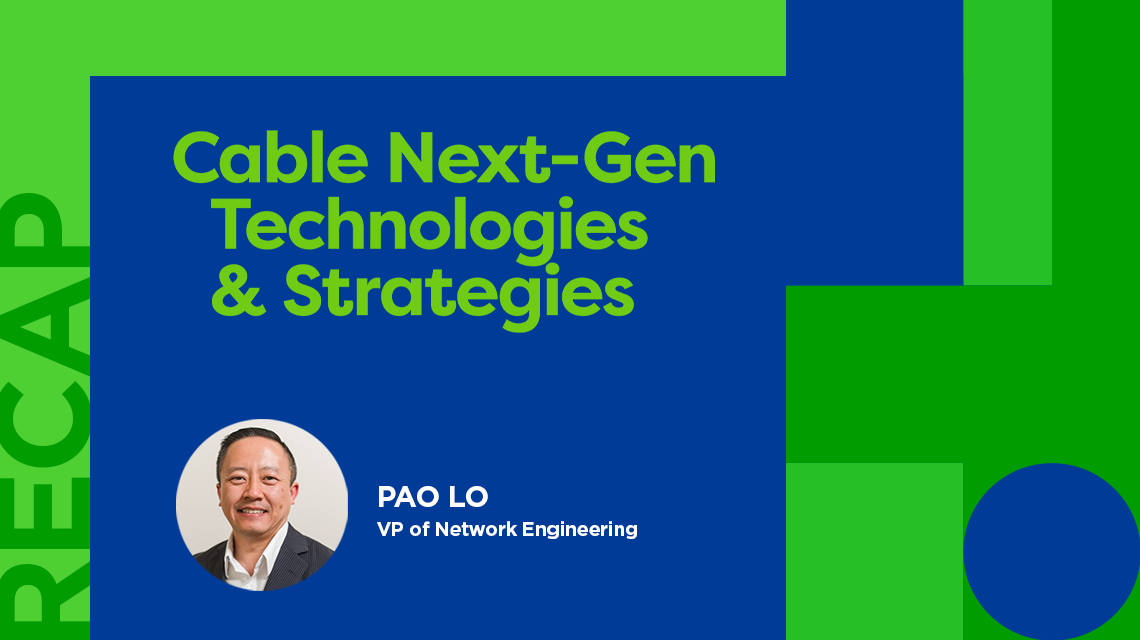Recapping the Cable Next-Gen Conference
By Pao Lo
Vice President of Network Engineering

At the 2022 Cable Next-Gen Technologies & Strategies conference, I was fortunate enough to deliver the keynote address. I spoke on DOCSIS 4.0 Network Architecture.
A somewhat standard technology in the industry, DOCSIS stands for Data Over Cable Service Interface Specification and is a term you may find familiar when thinking about cable modems.
The 4.0 version is the evolutionary standard following DOCSIS 3.1. Once implemented, this technology will support the next generation of hybrid fiber (HF) network with symmetrical download and upload speeds – one day making up to 10 Gbps speeds possible.
As a part of this topic, it’s important to consider the current-day landscape within the internet service provider (ISP) space. Today, there’s a flood of capital in broadband for both private and public purposes. With these funds, ISPs are building out fiber-optic networks to deliver more impactful connections to communities to meet the need for higher upload speeds. This is very exciting since building with fiber first typically comes with lower latency, more reliability, symmetrical uploads and downloads and overall futureproofing, but in turn moves us away from DOCSIS technology.
But from what I can tell, DOCSIS isn’t going away anytime soon based on the 4.0 vision. However, from a mid-tier operator’s perspective, the design around deploying DOCSIS 4.0 is dependent on factors such as:
- The version of DOCSIS 4.0 that’s the best fit, such as Full-Duplex (FDX) or Frequency Division Duplexing (FDD)
- Ideal iteration of Distributed Access Architecture (DAA), such as remote PHY or MAC PHY
- Quadrature Amplitude Modulation (QAM)-based video
- Existing Customer Premises Equipment (CPE)
- The supply chain issues impacting many providers
The reality: Multiple System Operators do not have the luxury of waiting for DOCSIS 4.0. However, we can take incremental steps to prepare for DOCSIS 4.0 on the legacy HF plant. It’s a balancing act between upgrading existing HF infrastructure and overbuilding with fiber-to-the-premises (FTTP).
Meanwhile, we find ourselves asking important questions. Do you cap HF? Do you grow FTTP?
The answers differ for every organization due to the different stages of technology lifecycle, capital of the organization and operational lift to convert to a new technology. These are the factors that will determine how widely DOCSIS 4.0 will be deployed. Additionally, the marketplace could change the dynamic or limit the scale of DOCSIS 4.0.
Midco will continue to stay open to the demands of the landscape today – with an eye on the future for tomorrow. Our path forward involves strengthening the communities we serve through innovation with advanced fiber technology. Ultimately, we strive to make technology accessible and available in the Midwest.

Pao Lo joined Midco in 2020 with more than 20 years of experience in advanced cable and optical technologies. As VP of Engineering, Lo focuses his expertise on network technology, reliability, advancement and performance while leading the Network Engineering team. He also works closely with our Field Operations, IT and Business Development teams – as well as many other groups across the organization. Pao has a bachelor’s degree in electrical engineering, an MBA and an educational doctorate in organizational leadership.

Pao Lo joined Midco in 2020 with more than 20 years of experience in advanced cable and optical technologies. As VP of Engineering, Lo focuses his expertise on network technology, reliability, advancement and performance while leading the Network Engineering team. He also works closely with our Field Operations, IT and Business Development teams – as well as many other groups across the organization. Pao has a bachelor’s degree in electrical engineering, an MBA and an educational doctorate in organizational leadership.
